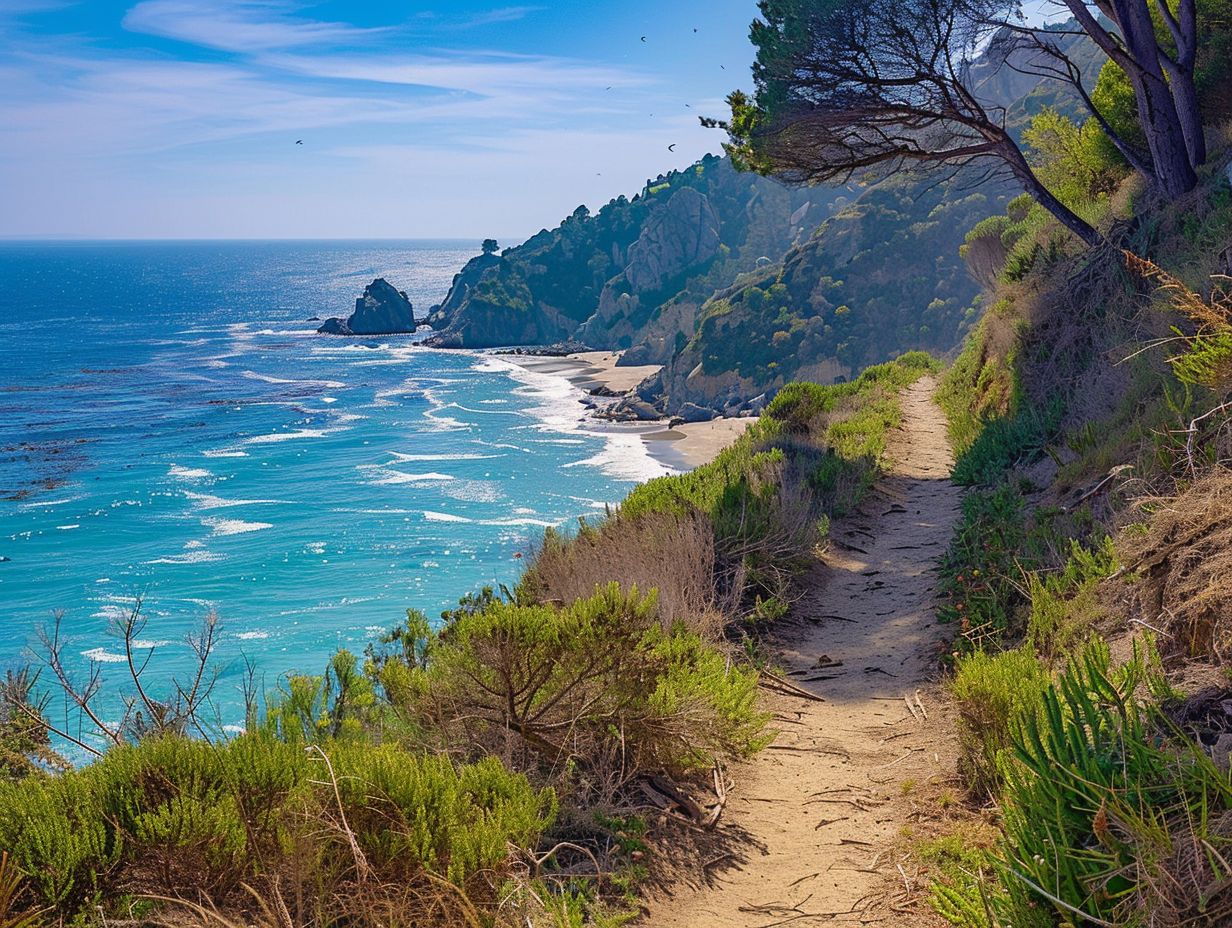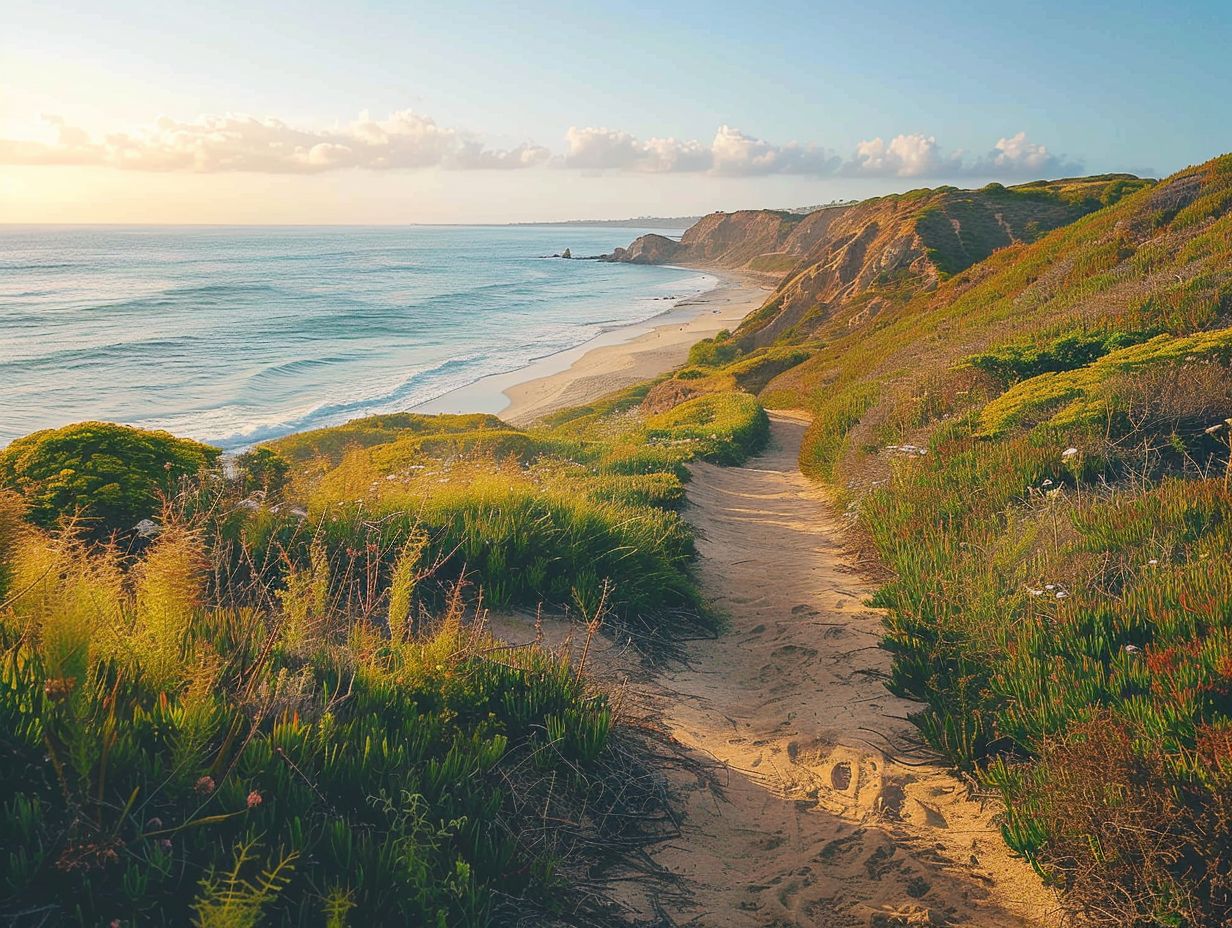Are you in need of a peaceful escape from the hustle and bustle of city life? Look no further than the deserted beaches of the UK. These hidden gems offer a unique and tranquil experience that is sure to rejuvenate your soul.
We explore what makes deserted beaches so special and the numerous benefits of visiting them. We also take a look at the top UK hikes that will lead you to these picturesque locations, as well as provide you with tips on how to prepare for your adventure.
Get ready to lace up your hiking boots and embark on a journey to discover the beauty of deserted beaches in the UK.
Key Takeaways:

- Experience a unique side of the UK by exploring its deserted beaches.
- Benefit from the tranquility and stunning views these hidden gems offer.
- Prepare for your hike by packing appropriate gear, following safety tips, and practicing Leave No Trace principles.
Top UK Hikes for Experiencing Deserted Beaches
The United Kingdom provides exceptional hiking opportunities for individuals seeking to explore deserted beaches. The scenic coastal routes offer striking views, diverse wildlife, and a harmonious combination of countryside and coastline.
1. South West Coast Path
The South West Coast Path in Cornwall is a well-known coastal trail in the United Kingdom, renowned for offering breathtaking views of the coastline and access to some of the country’s most exquisite deserted beaches.
Spanning over 600 miles, this path meanders through picturesque fishing villages, towering cliffs, and verdant landscapes. Hikers have the opportunity to behold remarkable natural landmarks such as Land’s End, the iconic Minack Theatre situated atop the cliffs, and the rugged splendour of Lizard Point.
The juxtaposition of rugged cliffs and tranquil sandy coves along the route provides a diverse and enthralling experience for individuals exploring this captivating coastal pathway.
2. The Lizard Peninsula

The Lizard Peninsula in Cornwall is renowned for its captivating coastal path and stunning landscapes, offering an idyllic escape for enthusiasts of nature.
Journeying through The Lizard Peninsula entails a captivating blend of rugged cliffs, secluded coves, and charming villages. Visitors traversing this captivating region will encounter notable landmarks such as the Lizard Lighthouse and Kynance Cove, celebrated for its crystalline waters and imposing cliffs.
The experience of arriving at the deserted beaches of The Lizard Peninsula is truly enchanting, with pristine sands and clear waters providing a tranquil setting for relaxation and introspection. Exploring this unspoiled corner of Cornwall presents an opportunity to reestablish a connection with nature and bask in its untainted beauty.
3. The Pembrokeshire Coast Path
The Pembrokeshire Coast Path in Wales presents a remarkable coastal route that guides hikers through breathtaking landscapes and provides opportunities to discover deserted beaches, whilst encountering abundant wildlife throughout the journey.
Extending for 186 miles along the picturesque Welsh coastline, the Pembrokeshire Coast Path exhibits a varied array of landscapes, ranging from rugged cliffs to sandy coves. Particularly noteworthy sections include the rugged northern portion encompassing St. Davids and the scenic southern areas near Tenby.
The pathway is rich in wildlife, offering the chance to observe seabirds, seals, and even dolphins along the route. A significant aspect of the trail is the opportunity to encounter secluded, unspoilt beaches where one can relax and appreciate solitude amidst the natural beauty.
4. The Isle of Skye
The Isle of Skye in Scotland presents hikers with magnificent landscapes and the chance to explore coastal villages and remote beaches, offering a distinctive amalgamation of natural splendour and cultural legacy.
The island is celebrated for its diverse array of hiking trails, designed to accommodate individuals of all skill levels. Ranging from the demanding slopes of the Quiraing to the serene paths surrounding the Fairy Pools, there exists an option for every hiking enthusiast.
Whilst navigating these paths, individuals are treated to awe-inspiring vistas of rugged cliffs, glistening lochs, and verdant valleys. The charming coastal villages encountered along the route provide insight into the local way of life, characterised by their vibrant residences and traditional taverns.
It is advisable to deviate from the path to uncover the hidden treasures of abandoned beaches, offering an opportunity to unwind in seclusion amidst the unbridled beauty of the Scottish coastline.
5. The North Coast 500
The North Coast 500 in Scotland is a renowned coastal route that offers hikers striking vistas and access to some of the most pristine deserted beaches, along with awe-inspiring coastal scenery.
Encompassing approximately 500 miles of magnificent landscape, the route meanders through rugged coastal cliffs, picturesque villages, and historic sites. Hikers have the opportunity to immerse themselves in the unspoilt beauty of Scotland’s north coast, with chances to observe wildlife such as seals and seabirds along the way.
The beaches lining the North Coast 500 are frequently secluded, presenting a tranquil escape for nature enthusiasts seeking a more remote and unspoilt environment. Featuring diverse terrain and challenging trails, this route provides an unforgettable adventure for hikers desiring to explore Scotland’s wild coastline.
How to Prepare for Hiking to Deserted Beaches?
In anticipation of setting off on a hike to remote beaches, meticulous planning is essential. This preparation involves gathering the appropriate gear, gaining a thorough understanding of safety protocols, and adhering to Leave No Trace principles to ensure a secure and considerate excursion.
What Gear Do You Need?
When embarking on a hike to remote beaches, it is imperative to have the necessary equipment for a safe and successful journey. This includes sturdy hiking boots, a well-detailed map, and appropriate attire suitable for the prevailing weather conditions along the coastal path.
Moreover, carrying a compass or GPS device is essential to maintain a proper sense of direction, particularly in areas where signal reception may be limited. Safety provisions such as a first aid kit, whistle, and emergency blanket must not be ignored, as they are crucial in times of need.
To optimise comfort throughout the hike, it is recommended to bring a lightweight rucksack containing essential items like snacks, water, and suncream. Additionally, preparing for varied weather fluctuations by carrying a waterproof coat, extra layers of clothing, and a hat ensures hikers can fully enjoy the beach hike regardless of changing environmental elements.
What Are Some Safety Tips?

Safety guidelines for hiking along coastal routes to remote beaches include staying on designated trails, being mindful of wildlife, and monitoring the weather conditions to fully appreciate the breathtaking views while minimising potential risks.
It is essential for hikers to acquaint themselves with trail maps and carry a compass or GPS device to ensure accurate navigation. If there is encountering wildlife, it is advised to maintain a safe distance and refrain from approaching or feeding them.
Prioritizing safety, hikers should always inform a trusted individual of their hiking plans and expected return time, particularly when venturing into isolated coastal regions. Additionally, being equipped with appropriate layers of clothing to accommodate changing weather conditions can be pivotal in distinguishing between an enjoyable hike and a hazardous situation.
By adhering to these safety precautions, hikers can enhance their outdoor experiences while prioritizing their well-being.
What Are Some Leave No Trace Principles?
Adhering to Leave No Trace principles while hiking is paramount to preserving the untouched beauty of the coastal path and deserted beaches for both future visitors and local wildlife.
Proper disposal of waste is essential for upholding the cleanliness and natural aesthetics of the surroundings. By appropriately managing rubbish and packaging materials, individuals play a crucial role in mitigating pollution and safeguarding the marine life in the coastal waters.
Showing respect for wildlife involves observing animals from a safe distance to avoid disrupting their natural behaviours or habitats. This practice not only supports the ecological balance but also minimises unnecessary stress or harm to the creatures.
Preserving natural objects in their undisturbed state maintains the environmental integrity and allows forthcoming hikers to savour the landscapes in their pristine condition.
What to Expect When Hiking to Deserted Beaches?
When embarking on a hike to remote beaches, it is advisable to anticipate encountering a wide range of terrains, diverse wildlife, and numerous challenges that necessitate thorough preparation and heightened awareness.
What Will the Terrain Be Like?
The terrain encountered on hikes to secluded beaches can exhibit significant diversity, encompassing a spectrum that includes rocky cliffs, sandy beaches, forested paths, and open countryside.
Rocky cliffs can pose a demanding physical challenge, necessitating the utilisation of robust footwear and meticulous navigation techniques to mitigate the risk of slips and falls. In contrast, while a leisurely walk along sandy beaches may provide a calming experience, the softness of the sand can impose physical strain.
Forested paths offer shade and seclusion, yet hikers must exercise caution due to uneven terrain and tree roots. Open countryside presents expansive vistas, but exposure to the elements underscores the importance of adequate sun protection and hydration.
To adequately prepare for these varied terrains, hikers are advised to dress appropriately, carry an ample supply of water, and remain vigilant of their surroundings in order to fully immerse themselves in the beauty and challenges inherent in each landscape.
What Wildlife Might You Encounter?
Whilst hiking along coastal paths to deserted beaches in the UK, one may encounter a variety of wildlife, including sea birds, marine life, and occasionally seals.
The coastal areas in question are frequently inhabited by seabirds such as puffins, gannets, and terns, which are observable either gliding through the skies or nesting along the rugged cliffs. The marine ecosystems within these regions exhibit a diverse array of species, with inquisitive seals often observed sunbathing on the rocks or swimming in proximity to the shore.
It is imperative to bear in mind that these habitats constitute fragile ecosystems; therefore, demonstrating a deep respect for the wildlife by maintaining a respectable distance is paramount to ensuring their sustained well-being and conservation.
What Are Some Challenges to Be Aware Of?
When embarking on coastal hikes to secluded beaches, it is important to remain vigilant of various challenges that may arise. These challenges include the unpredictable weather conditions, the complexities of navigation in such terrains, and the physical demands imposed by the rugged landscapes.
An inherent challenge faced by hikers in coastal regions is the swiftly changing weather patterns, ranging from scorching sunshine to abrupt rainstorms. Therefore, it is imperative to equip oneself with the appropriate gear and attire to adapt to these fluctuations effectively.
Furthermore, navigating through the rough terrains and dense vegetation prevalent in such areas can be arduous. To mitigate this challenge, it is recommended to carry navigational aids such as maps, GPS devices, or compasses to ensure a successful journey.
Moreover, the physical stamina required to traverse uneven surfaces and steep inclines necessitates adequate conditioning prior to undertaking such hikes. Proper physical preparation is essential to prevent injury and fatigue during the hike.
To address these challenges effectively, strategic planning is imperative. This includes checking weather forecasts, ensuring proper hydration throughout the hike, and maintaining a consistent pace to enhance safety and overall enjoyment of the journey.
Frequently Asked Questions

What are the best UK hikes for experiencing deserted beaches?
Some of the best hikes for experiencing deserted beaches in the UK include the South West Coast Path, the Pembrokeshire Coast Path, and the Northumberland Coast Path.
How do I choose the right hike for me?
The best way to choose the right hike for you is to consider your fitness level, the length and difficulty of the hike, and the location. You can also do some research on specific hikes to see if they have any deserted beaches along the route.
What should I pack for a hike to a deserted beach in the UK?
It is important to pack essentials such as water, snacks, a map, and appropriate clothing and footwear. You may also want to bring a camera, sunscreen, and a first aid kit. Be sure to prepare for different weather conditions as well.
Are there any safety precautions I should take when hiking to deserted beaches in the UK?
Yes, it is important to always let someone know your planned route and estimated time of return. Be sure to stay on designated trails and be aware of any potential hazards such as tide changes or slippery rocks. It is also a good idea to bring a fully charged phone in case of emergencies.
Can I camp on deserted beaches along these hikes?
Most of the beaches along these hikes do not allow camping, but there are some designated camping areas nearby. It is important to check with local authorities and obtain any necessary permits before camping. Wild camping is not permitted in most areas in the UK.
Can I bring my dog on these hikes to deserted beaches?
Some beaches may allow dogs, but it is important to check local rules and regulations before bringing your furry friend along. Be sure to also keep your dog on a leash and clean up after them to respect the natural environment and other hikers.

